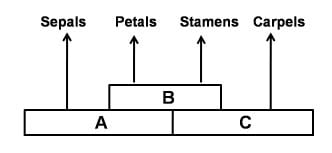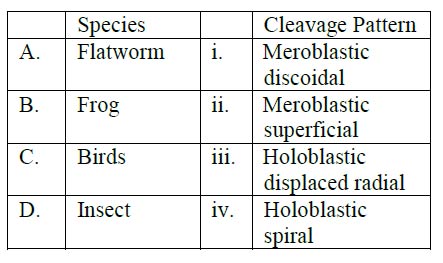Dear Students,
Welcome to Developmental Biology MCQ – 04 (Developmental Biology CSIR NET MCQ). This MCQ set consists of Advanced Developmental Biology / Embryology Multiple Choice Questions taken from the previous year question papers of CSIR NET Life Sciences Examination. These questions can be used for the preparation of Competitive examinations in Biology / Life Sciences such as CSIR NET, ICMR JRF, DBT BET JRF, GATE and other University Ph.D Entrance Examinations.
You may also like: Developmental Biology Notes
(1). Cancer is often believed to arise from stem cells rather than fully differentiated cells. Following are certain views related to the above statement. Which one of the following is NOT correct?
(a). Stem cells do not divide and therefore require fewer changes to become a cancer cell.
(b). Cancer stem cells can self-renew as well as generate the non-stem cell populations of the tumor.
(c). Teratocarcinomas prove tumors arise from stem cells without further mutations.
(d). Stemness genes can often function as oncogenes.
Ans. (a)
(2). Given are certain facts which define ‘determination’ of a developing embryo.
(A). Cells have made a commitment to a differentiation program.
(B). A phase where specific biochemical actions occur in embryonic cells.
(C). The cell cannot respond to differentiation signals.
(D). A phase where inductive signals trigger cell differentiation.
Which of the above statements best define determination?
(a). B and D
(b). A and C
(c). Only A
(d). Only B
Ans. (c)
(3). What would happen as a result of a transplantation experiment in a chick embryo where the leg mesenchyme is placed directly beneath the wing apical ectodermal ridge (AER)?
(a). Distal hindlimb structures develop at the end of the limb.
(b). A complete hindlimb will form in the region where the forelimb should be.
(c). The forelimb would form normally.
(d). Neither a forelimb nor a hindlimb would form since the cells are already determined.
Ans. (a)
(4). If you remove a set of cells from an early embryo, you observe that the adult organism lacks the structure that would have been produced from those cells. Therefore, the organism seems to have undergone.
(a). Autonomous specification.
(b). Conditional specification.
(c). Morphogenic specification.
(d). Syncytial specification.
Ans. (a)
(5). Dose-dependence of retinoic acid treatment supports the notion that a gradient of retinoic acid can act as a morphogen along the proximo-distal axis in a developing limb. Following are certain facts related to the above notion.
(A). Treatment with high level of retinoic acid causes a proximal blastema to be respecified as a distal blastema and only distal structures are regenerated.
(B). Treatment with high level of retinoic acid causes a distal blastema to be respecified as a proximal blastema and regeneration of a full limb may be initiated.
(C). Treatment with retinoic acid affects only distal blastemas and causes them to form only proximal structures.
(D). Treatment with high level of retinoic acid causes any blastema to form only distal structures.
Which one of the following is correct?
(a). B and D
(b). Only C
(c). A and C
(d). Only B
Ans. (d)
(6). According to the ABC model of floral development in Arabidopsis as shown below,

Several genes/transcription factors e.g. AP1, AP2, AP3, AG etc., are involved. Which one of the following statements is correct?
(a). Apetala 2 (AP2) transcripts expressed during sepal and petal development.
(b). Agamous AG is considered as class A gene.
(c). AP1 expressed during carpel development.
(d). AP3 expressed during sepal development.
Ans. (a)
(7). Match the following cleavage patterns with the species in which they occur. (CSIR_2017_II)

(a). A – iv, B – iii, C – i, D – ii
(b). A – iii, B – i, C – iv, D – ii
(c). A – ii, B – iii, C – i, D – iv
(d). A – ii, B – iv, C – iii, D – i
Ans. (a)
(8). Which one of the following statements regarding limb development in mice is true?
(a). The gene encoding Tbx5 is transcribed in the limb fields of the hindlimbs.
(b). The gene encoding Tbx4 is transcribed in the limb fields of the forelimbs.
(c). Genes encoding Islet 1, Tbx4 and Pitx are expressed in the presumptive hindlimb.
(d). Genes encoding Islet 1, Tbx4 and Pitx are expressed in the presumptive forelimb.
Ans. (c)
(9). C. elegans embryo uses both autonomous and conditional modes of specification. Conditional specification at the 4-cell stage can be seen in the development of the endoderm cell lineage and also in the establishment of dorsal-ventral axis. Following are few statements regarding this:
(A). If the P2 cell is removed at the early 4-cell stage, the EMS cell will divide into two MS cells and no endoderm will be made.
(B). In pop-1 deficient embryos, both EMS daughter cells become E cells.
(C). When the position of ABa and ABp was reversed, their fates get reversed and no normal embryo forms.
(D). In embryos whose mother have mutant glp-1, ABp is transformed into ABa cell.
Which of the above statements are true?
(a). A, B and D
(b). A, B and C
(c). B, C and D
(d). A, C and D
Ans. (a)

Pharmaceutical Microbiology